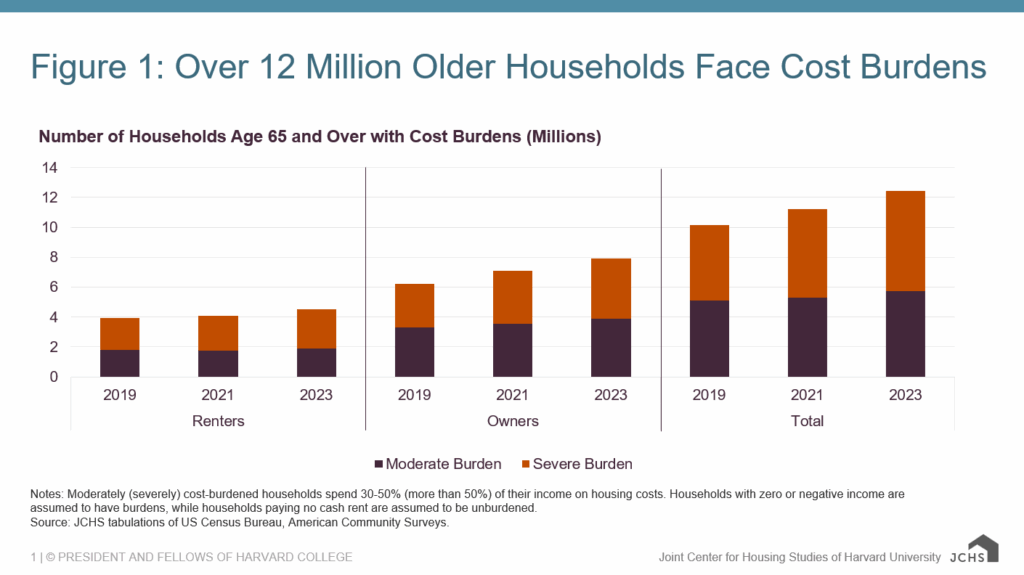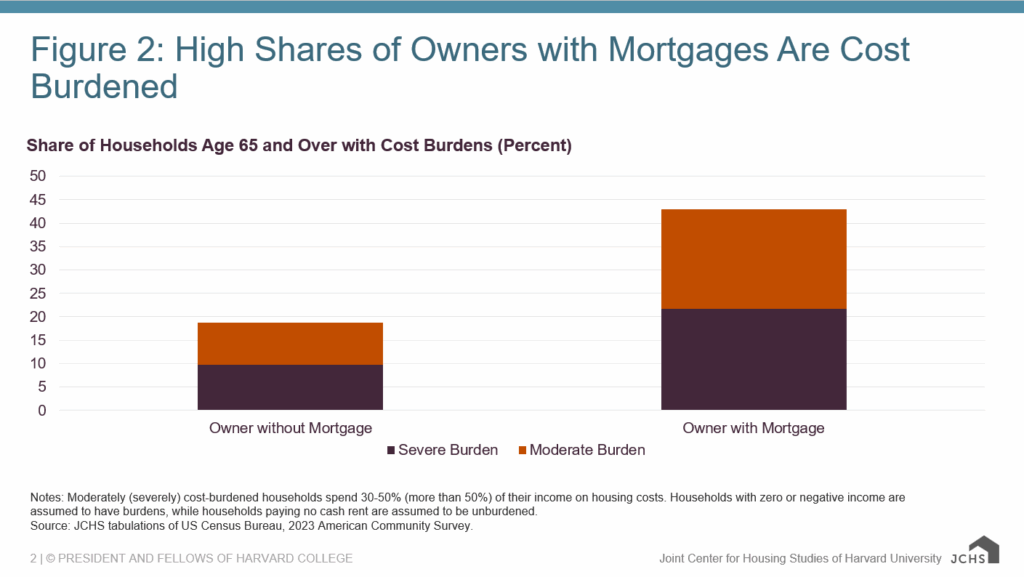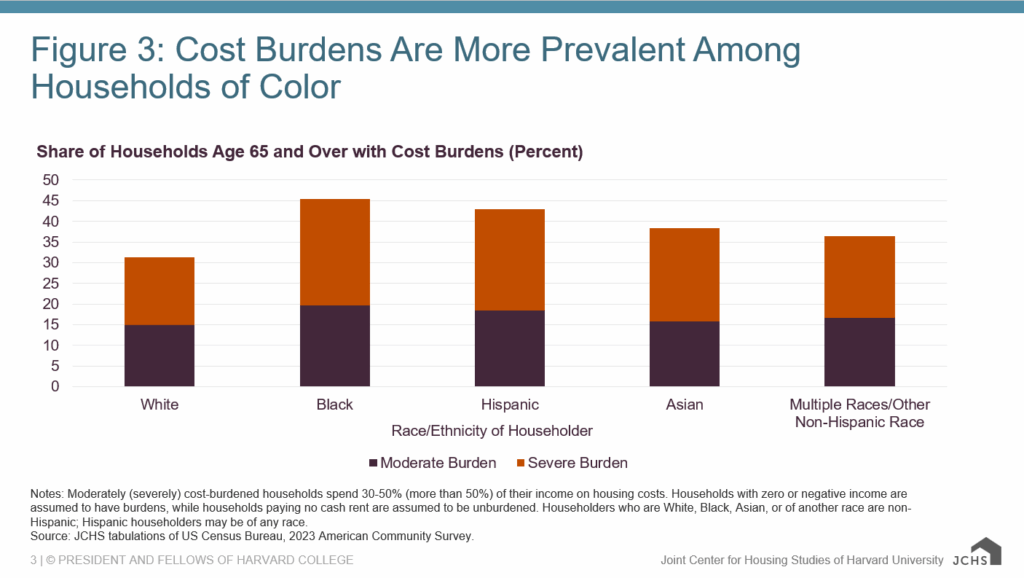In 2023, over one-third (34%) of older households were cost burdened, paying more than 30% of their income for housing, per the Joint Center for Housing Studies’ recently released housing affordability report, State of the Nation’s Housing 2025. (Older households are defined as those led by someone age 65 or over.)
This 34% is a new high, over 12.4 million households—an additional 2.3 million households since 2019. Worse, more than half of these households (6.7 million) pay over 50% of their income for housing, making them severely cost burdened (Figure 1).

Note on charts: Moderately (severely) cost-burdened households spend 30-50% (more than 50%) of their income on housing costs. Households with zero or negative income are assumed to have burdens, while households paying no cash rent are assumed to be unburdened.
Both renters and owners increasingly struggle with housing costs
Fifty-eight percent of older renters (4.5 million households) were burdened in 2023. That’s an increase of over 570,000 households between 2019 and 2023—and the majority were severely burdened. Older renters are more likely to live on fixed incomes that may not keep up with rising rents, leaving those with lower incomes little left over in the household budget to pay for out-of-pocket costs like medicine, food, and other necessities. Cuts to Medicaid and nutrition assistance in the recent reconciliation bill mean even less support for the most vulnerable of these households.
Owing to the high homeownership rate among older adults, older homeowners are a far larger group, and are not immune from growing affordability challenges. Between 2019 and 2023, the cost-burden rate for older homeowners rose from 24% to nearly 28%. That lifted the number of cost-burdened older homeowners to 7.9 million, an increase of over 1.7 million since 2019. The number of households with cost burdens rose to 4.1 million, up 1.1 million households from four years prior.
Older owners with mortgages are even more likely to face affordability challenges. 43% of older owners with mortgages are cost burdened, compared to 19% of those who own without a mortgage.

The number and share of older adults with mortgages have grown over the past decades: in 2022, 31% of owners 80 years and older held a mortgage. Even those without a mortgage are not immune: steep increases in property insurance are still contributing to affordability challenges, especially in areas with the greatest risk of climate-related disasters.
Affordability challenges are more prevalent among households headed by people of color, with cost burdens rates almost half (nearing 46%) for Black older adults and 43% for Hispanic older adults. Householders who are Black, Hispanic, Asian, or of other/multiple races are also more likely than white households to have severe cost burdens.

Notes: Householders who are White, Black, Asian, or of another race are non-Hispanic; Hispanic householders may be of any race.
Cost burdens are also more prevalent in certain age groups, such as those 80 and over. The Joint Center of Housing Studies estimates that group will double over the next two decades. Nearly 40% of households in this age group are burdened, compared to just over 32% of those aged 65-79.
These higher rates of cost burdens reflect a decline in median income among people 80+, in part driven by an increase in single-person households. As the baby boomers turn 80 in large numbers, the study expects more people will struggle to meet housing costs as the need for in-home services and accessibility modifications also grows.
Growing challenges require greater levels of assistance
Older households increasingly need support affording housing, as well as the services they may need to remain in their homes. Yet even now, need outstrips available assistance. Federal rental assistance is underfunded for very low-income older adults: at last measure in 2021, of older adults earning no more than 50% of the area median income and thus qualifying for federal rental assistance, only 36.5% received it. The majority of the unassisted households were severely cost burdened, lived in severely substandard conditions, or both.
In addition to existing shortfalls in aid, proposed cuts to federal funding for rental assistance could be devastating for the older population living on fixed incomes. Cuts to Medicaid and nutrition assistance in the recent reconciliation bill will also mean diminished support for the most vulnerable households, further stretching household budgets. Already, people age 50 and over represent the fastest growing population of unhoused people in the US. Helping people stay stably housed is far more cost-effective, and far more supportive of individuals’ independence and dignity.
Older homeowners with low incomes and limited wealth may have to make difficult tradeoffs. Help addressing housing affordability typically comes from property tax relief implemented by state and local governments, assistance with home repairs and modifications offered through governmental and nonprofit sources, and energy efficiency programs that can reduce utility costs.
But given the rise in the numbers of older, cost-burdened homeowners with limited resources, there is also a need for assistance for those struggling to manage monthly mortgage and insurance payments. Some options include:
- More tools with which to draw safely on a home’s equity – But many people who live in lower-cost areas lack the resources to invest in their homes, or have debt or credit problems, which make extracting equity while remaining in the home difficult.
- Selling one’s home and relocating to less expensive housing in one’s community – In reality, this is limited by a dearth of affordable housing and suitable alternatives in many locations.
Preserving and expanding the supply of affordable, accessible housing is also important to ensure that both older owners and renters—as well as households of all ages with limited resources—have suitable housing options should current homes become too expensive, isolating, or difficult to navigate or manage. Increasing allocations to the Low-Income Housing Tax Credit program can help, but there is also a need for communities to allow the construction of smaller homes and apartments near services and amenities. For renters and owners alike, there is also a role for emergency assistance for short-term challenges paying housing costs, particularly now that pandemic-response efforts have mostly ended.
Reducing existing safety net programs will only be more costly in the long run, and the cost of not addressing the affordability crisis is far too great for individuals, families, and society itself.
The post Study: One in Three Older Households Is Cost Burdened first appeared on The MortgagePoint.
























